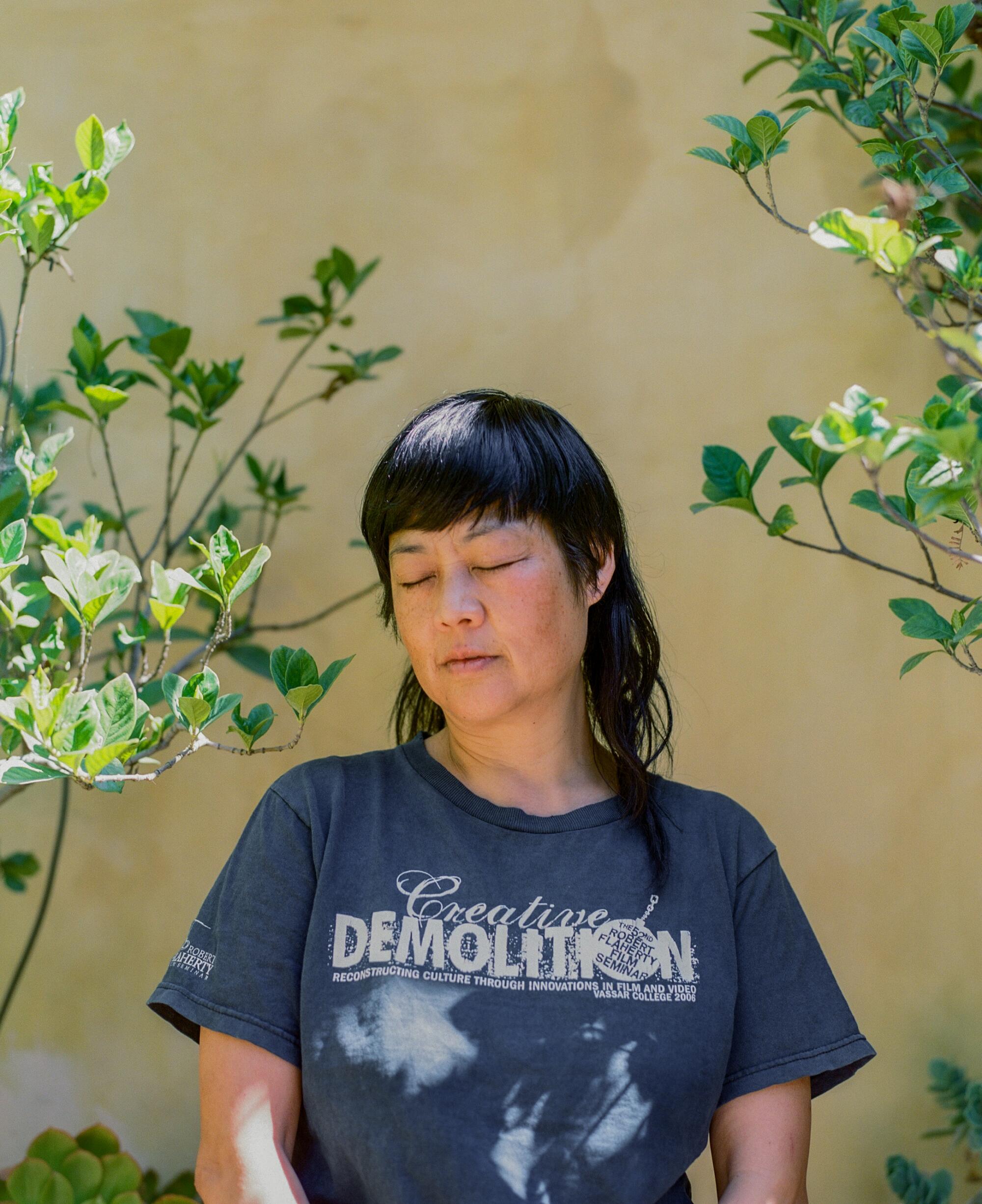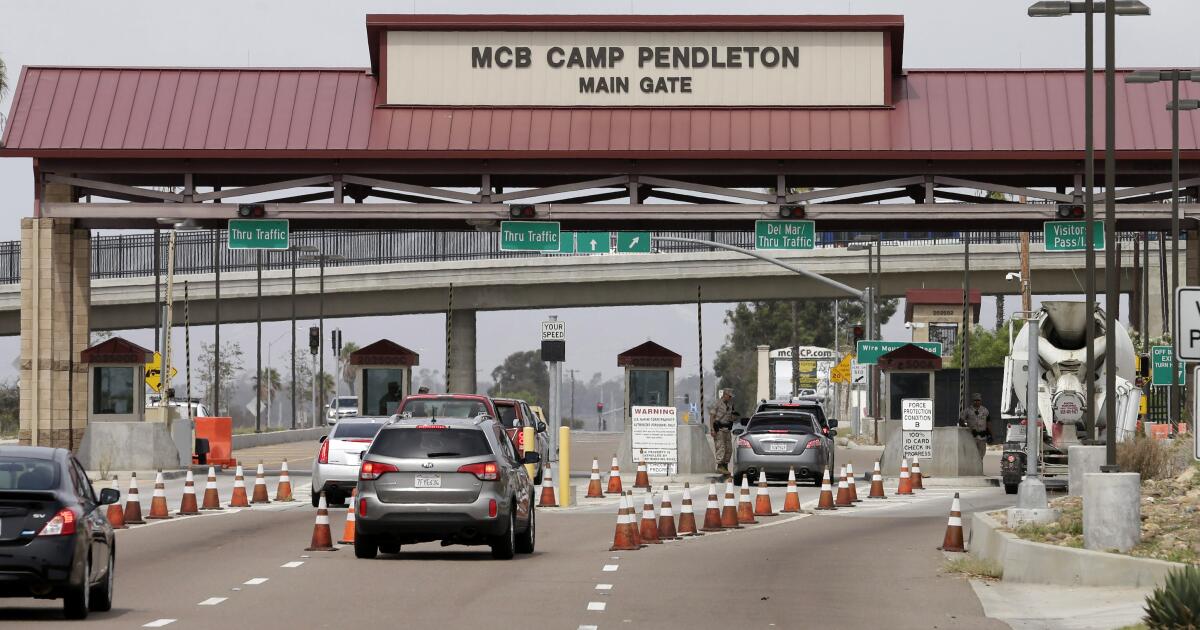The L.A.-based artist Patty Chang.
(June Kim / For The Times)
When schools shut down in March 2020, artist Patty Chang decided that she needed an above-ground swimming pool. “That was the first thing I thought,” Chang recalls. “Because, what are they going to do?” Her son Leroy, then 8, was in a pod with four other children, and she felt like the pool would provide the perfect container, a predetermined activity for these newly unmoored children. They ordered one online, set it up in the backyard, and all summer, the children swam.
Two years later, when the pool’s urgent usefulness had receded and the lightly chlorined water had grown dark with algae, it served another purpose. It became the film set for the final act of “We Are All Mothers” (2022), a video essay by Chang currently on view in “Scratching at the Moon” at the Institute of Contemporary Art, Los Angeles, an intimate exhibition of Asian American artists working in Los Angeles. When she was working on the video, Chang asked her son if he would swim with her. He agreed and the two of them donned wet suits on a cold night and used GoPros to film underwater. The resulting footage feels familiar, playful and also ethereal — sometimes it’s clear that we are watching a body swimming, and other times, all we get is a blur of light, a glimpse of hair, or the blown-out colors of the wet suit blurred by water. While this imagery plays out onscreen, Chang’s clear, resolved voice lists the crises specific to birthing and raising a child: “The crisis of not being able to work. The crisis of the body and mind not being one’s own.”
“We Are All Mothers” encapsulates themes that have preoccupied Chang for years: the relationship between the outside world and one’s own body, including bodies of water and bodily fluids, and the powerful yet elusive notion of care. Care, for Chang, has as much to do with traditional forms of caregiving as it does with a need to care for the environment. It also has to do with fear. Anxieties, exacerbated by parenthood and climate change, punctuate her recent projects, which are tangibly relevant in the wake of a pandemic that pushed caregivers to breaking points and during an election year in which Donald Trump is promising to roll back environmental protections. Less tangibly, Chang’s work acknowledges and invokes collective fear in such a way that the fear itself begins to feel less like a barrier and more like an opening into a more communal, porous version of the world.
In April, I visited Chang in her Altadena studio, which is currently also her living room. For years, she worked out of her garage. Then, two years ago, she and her husband and longtime collaborator, David Kelley, began construction to replace their garage with a two-story studio building. Due to an errant electrical wire running through their backyard, however, construction stalled as they waited for necessary city permissions. In the meantime, she has learned to focus amid the distractions of family life.

“With all the artworks, I feel like the whole process changes everything that I know and everything that I think about,” says Chang.
(June Kim / For The Times)
Her studio currently contains in-progress sculptures on the floor — painted porcelain plates meant to resemble the tools used to measure turbidity or clarity of water — and research materials on the desk, including images of the polymetallic nodules found at the bottom of the sea. These are for an in-progress project that she and Kelley will exhibit at the San José Museum of Art in the fall. Titled “Stray Dog Hydrophobia,” it takes as its jumping-off point the United Nations’ 2023 decision to allow deep sea mining in areas outside national jurisdictions, and it continues Chang’s ongoing interest in the relationship between the ocean and the human body. She and Kelley had gone to Kingston, Jamaica, in March to attend the United Nations International Seabed Authority’s 29th annual conference, not quite sure what usable material they would find. They ended up joining marine biologists on a boat trip to the “sunken pirate city,” which fell into the water after a 1692 earthquake and still offers archaeologists rare glimpses into 17th century life, remaining a profound example of the entanglement between humans and the ocean.
“With all the artworks, I feel like the whole process changes everything that I know and everything that I think about,” says Chang. “And why else would I do this? Because nobody wants you to do it.”
Patty Chang was born in 1972 in San Leandro, Calif., south of Oakland. Her parents, Chinese immigrants, stayed in the East Bay after her father’s PhD studies at UC Berkeley led to a job in computers. Chang grew up there, drawing and painting throughout her childhood. “I have no other skills,” she says, explaining why studying art seemed the obvious choice. She attended UC San Diego because it offered her the most scholarship money and it was both in-state and far from her family. The renowned art faculty at the school, a hotbed for conceptual and performance artists since the late 1960s, did not play a role in her decision. Later, when she realized who her professors were, “it was shocking.” Artist Eleanor Antin, a feminist polymath with a sharp wit, encouraged Chang to enroll in a performance class her senior year, and by the time she graduated in 1994, Chang was a performance artist.
She moved to New York, where she quickly became a prolific presence in an alternative scene galvanized by the culture wars, devising performances that had the concision of a well-told joke. She worked out of her apartment, using props from thrift stores and supermarkets to hone ideas that often came to her quickly. “I could do whatever I wanted, anytime, anywhere,” Chang recalls. For “Alter Ergo” (1997), she wore a gray skirt suit and a white collared shirt buttoned all the way up, and used a dental clamp to hold open her mouth, which she’d stuffed with peppermint candies. She stood this way until her saliva caused a pink trickle to drip down her chin, eventually staining her suit. She first performed this in Soho at the nonprofit Exit Art’s 1997 showcase of new performance, prompting critic Margaret Sundell to describe Chang’s “distinctive brand” as “’60s-style body art meets ’90s riot grrrl feminism.” For “Melons” (1998), a three-minute video performance, she wore a bulky white brassier with two melons stuffed into the breasts. As she balanced a plate on her head, she used the long blade of a serrated knife to saw through the brassier’s left side, exposing the melon. Then she ate, spooning the fruit’s pink flesh out of what looked like her breast.
“Those first videos and performances were so strong and stark, and shocking,” artist Anna Sew Hoy told me. “They really felt dramatic when they happened.” Sew Hoy, who curated the current ICA show, recalls first meeting Chang at a backyard mud wrestling event in New York in the late 1990s. Their friendship expanded across the early aughts as they were both included in important shows of Asian American artists, such as “One Way or Another: Asian American Art Now,” an exhibition co-organized by the late L.A. curator Karin Higa, which posited that Asian American artists were initiating new, manifold and defiant ways of thinking about and making art.
In that show, Chang included “In Love” (2001), a two-channel video in which she appeared to be French kissing each of her parents. Actually, Chang had asked them to eat an onion with her, knowing that the act would resemble a make-out session, something culturally untoward and uncomfortable to watch. Chang’s parents rarely discussed her work with her, yet they agreed to participate, an act of generosity that, like Chang’s future work, tenderly conveyed intimacy as a way into bigger questions about how we care for each other while living in an often-hostile world.
Using your own body in performance can take its toll. Chang had started showing with the commercial gallery Jack Tilton in 1998, leading to market demands for more videos and performances. “Because I was involved in all of the work, there was a real pressure on me,” she recalls. “And I guess there was a sense of losing control of my autonomy.” A $50,000 commission from the Hammer Museum in 2004 gave her the support she needed to take a break from performances involving her own body and reimagine how she worked. It was during that time that she began her collaborations with David Kelley, making films about how human intervention has changed the landscape and the lives of its inhabitants. One film, “Shangri-La” (2005), explores the real-life corollary of the fictional Tibetan paradise-like town of Shangri La, a 1933 invention of the British novelist James Hilton. “Flotsam Jetsam” (2007) centers on the Three Gorges Dam on the Yangtze River in China, the recent construction of which had forced the relocation of 1 million people.
It wasn’t until Chang became pregnant that she began bringing her body back into the work. She was developing her project “The Wandering Lake,” for which she sought out disappearing bodies of water around the world. In 2012, pregnant with her son, Chang traveled to Muynak, Uzbekistan, near the Aral Sea. Once among the world’s largest lakes, the sea began disappearing in the 1960s, after the Soviets rerouted rivers for irrigation. Immobilized by morning sickness, Chang was physically unable to prioritize work over what was happening in her body.
“I could smell everything and I felt like I was going to vomit all the time,” she recalls. “The separation between me and what was outside of me was becoming really thin, so I started thinking about the project through that experience.” As her bodily experience reentered the work, it fortified her interest in the relationships between humans and the natural environment.
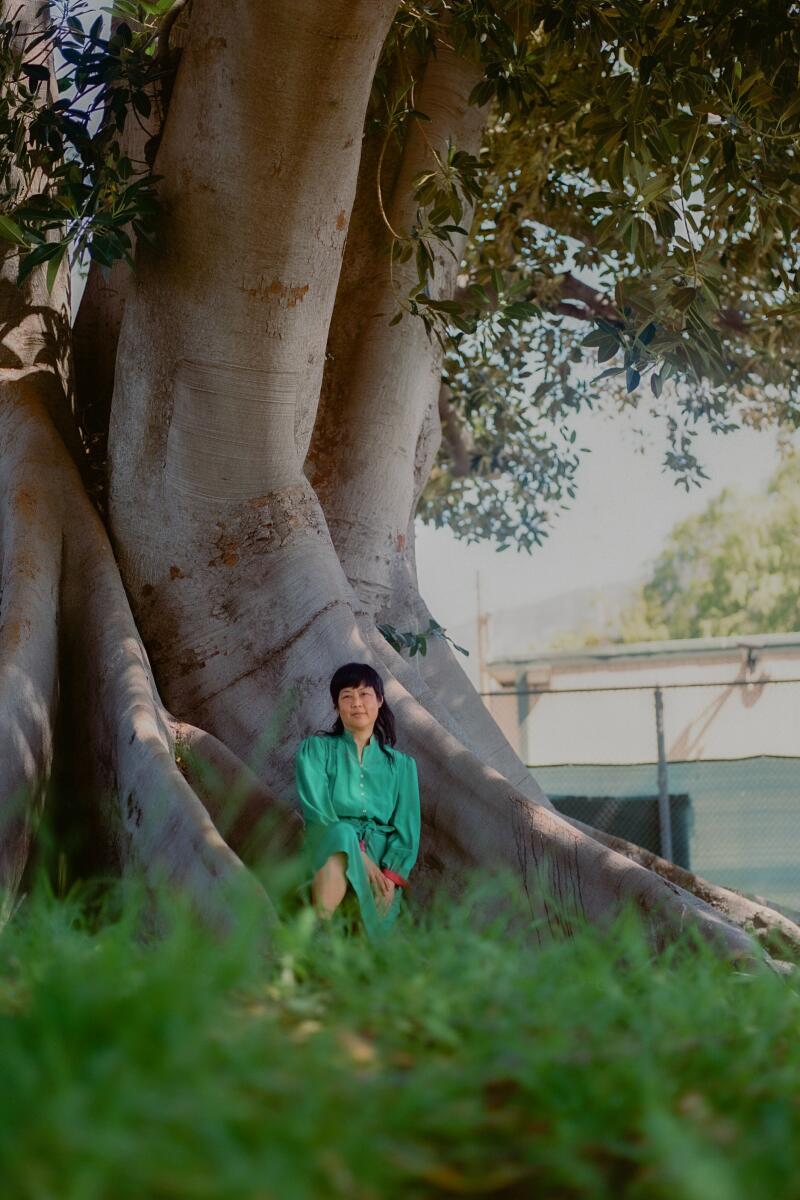
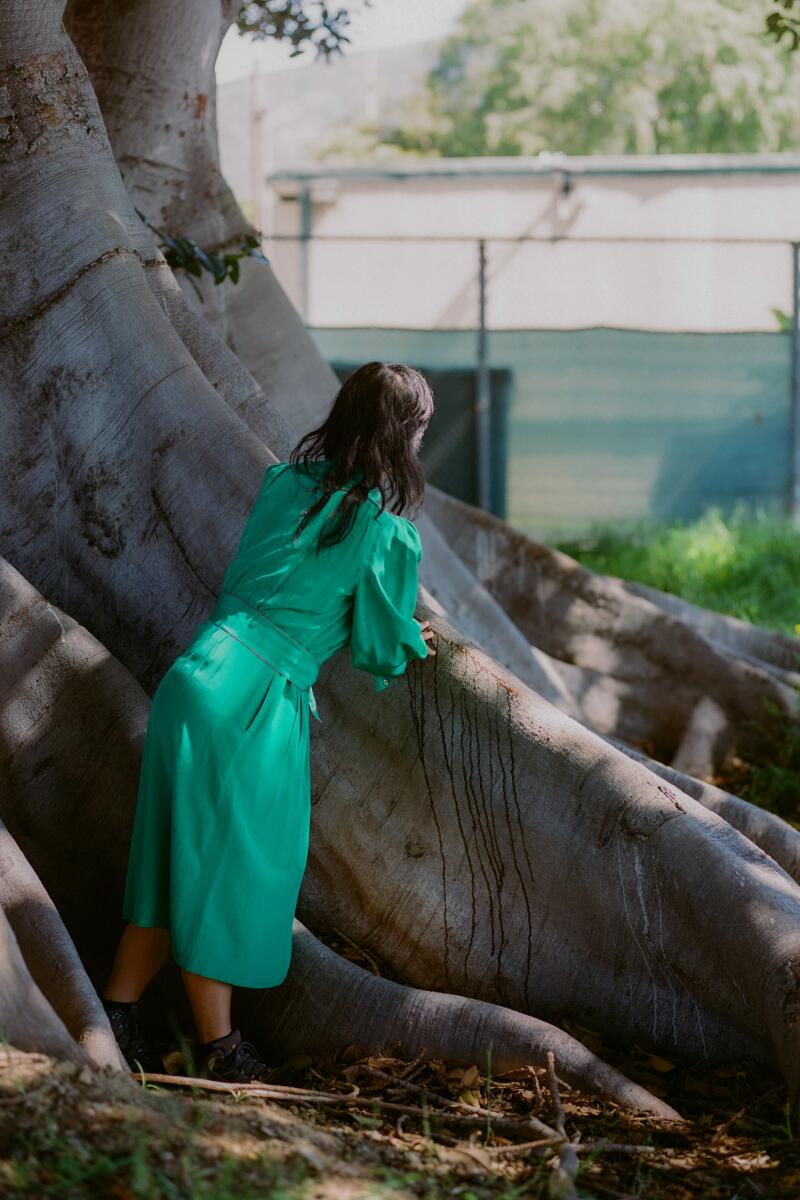
(June Kim/For The Times)
Two years later in 2014, when she was weaning her son and mourning her father’s death from a neurological illness, Chang returned to Uzbekistan to travel along the Aral Sea’s outer edges. She decided to pump breast milk along the way, usually during meals. Since her son no longer needed the milk, she dumped it where she could: in cups on the table or disposable food containers. Since the authoritarian government prevented her from filming the outdoor built environment, photographs of this milk became the record of her journey. In the essay she later wrote about the experience; she called the pumping and discarding “a sympathetic loss of flow,” her own dwindling milk supply mirroring the disappearing sea. Even when it is not physically uncomfortable, pumping is unwieldy, and the act, alongside the resulting photographs, perhaps showed Chang’s care for the landscape, and her commitment to spending time with it, more effectively than images of the wider environment would have.
“The Wandering Lake” became an exhibition at the ICA Los Angeles in 2017, the same year Chang moved to Los Angeles. She and Kelley had both taken jobs at USC and the summer after they moved into their Altadena home was the hottest in California history, with highs surpassing 110 degrees. “Being in L.A. just started compounding all my environmental anxieties that I already started having after I gave birth,” Chang says. “I felt I needed to do something about it.”
“Death”
“Leroy’s future death”
“death of the human species”
“113 degrees everyday”
“water running out”
These are among the 24 items that Chang included in her first “list of fears” in 2018. She wrote them while finding solace in the well-air-conditioned Huntington Library, using the library’s thin research paper. She had always enjoyed working in libraries, but the Huntington’s perfect climate control — always 68 degrees — felt like an antidote to a drought-stricken Los Angeles during a summer in which the Woolsey fire burned almost 100,000 acres. “It was like an escape, the perfect temperature for preservation,” she says.
Soon after she compiled her list, Chang met the performer Kestrel Leah. Leah had just given birth, and though Chang’s son was now older, she still associated so many of her anxieties with early parenthood. She told Leah about her list of fears, which she had initially written out of personal necessity. They decided that Leah would recite fears — Chang’s and others casually collected from friends — while pumping milk, and Chang would film her. But as soon as Leah began pumping, she couldn’t remember the script that she had memorized. The bodily activity of milk-making distracted her. That’s how the format for the project “Milk Debt” took shape: pumping performers reading fears off of a teleprompter.
When the 18th Street exhibition of “Milk Debt,” scheduled to open in May 2020, was delayed due to COVID-19 lockdowns, Chang took the opportunity to solicit more fears and film more performers, this time on Zoom — parents pumping after long days, with the fullness of their domestic settings in the background. The show that finally opened in September 2020 not only resonated with pandemic realities, it directly reflected them. “If a single artwork could sum up the cultural gestalt of a pandemic-gripped, politically anxious global citizenry in 2020, … Patty Chang’s Milk Debt does,” wrote Jennifer S. Li in Art Asia Pacific.
I first saw “Milk Debt” online like most viewers, and I intuitively understood the shared care work of pumping, alongside the shared acknowledgment of anxieties, as an articulation of collectivity in the face of precarity. Later, when I revisited the work after the birth of my twins — having experienced the literal and metaphorical pressure of the breast pump — I reveled more in how the intense and mundane bodily experience coexisted with as many petty fears as noble ones. Like the experience of new parenthood, “Milk Debt” dissolved hierarchies, treating even little things, like stress over grocery shopping, as deserving of care.
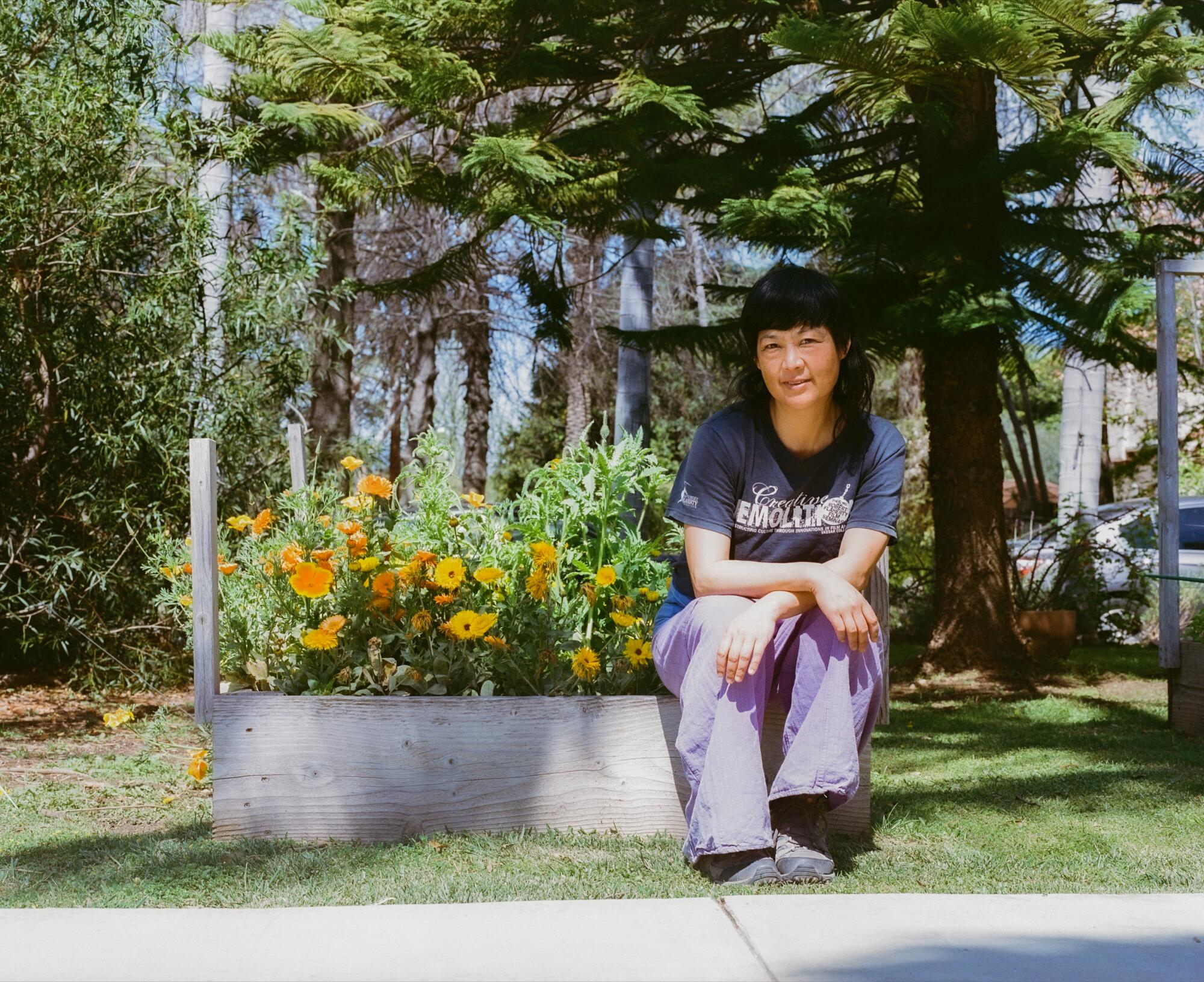
(June Kim / For The Times)
Before following her and her son underwater, Chang’s video at the ICA, “We Are All Mothers,” lingers on a starkly different kind of imagery. We watch as gloved hands caress and then examine a deceased porpoise, its sleek gray body laid out on a cool metal table. The footage came from a collaboration between Chang and the historian Astrida Neimanis and her sister, Aleksija Neimanis, a wildlife pathologist.
Throughout 2021, the three of them would meet on Zoom, Astrida and Chang, both based on the West Coast, getting up in the middle of the night to observe Aleksija in Sweden performing necropsies — autopsies for animals — of deceased porpoises. One night, while Chang watched from her garage, Aleksija discovered breastmilk in the belly of a young porpoise, which prompted Chang to get up the next morning and write about the porpoise’s mother, revisiting her fears about her own child’s death. In the video, she imagines an earthquake or car accident leaving her son with mortal injuries. “What would I do for him while he was dying?” she asks. “Say comforting thoughts to him?” After months of virtually convening, the collaborators finally met in person in September 2022 in Seattle, to lead a walk along the shore to the spot where a beached humpback whale died in 2016, and consider what the whale could teach us about how we care for each other.
When Anna Sew Hoy was organizing “Scratching at the Moon” at the ICA, it made sense to include “We Are All Mothers.” Not only was it Chang’s most recent work, but it reflected what Sew Hoy admires about her friend. “Patty won’t look away from environmental devastation,” Sew Hoy says. “She goes there, and that’s her bravery.” For her own part, Chang feels less brave than compelled to do something with her fears. “I think about how catastrophic thinking can be generative, how to not keep it in the loop, but to bring it out into something else,” she said that afternoon I visited her home-slash-studio, when I asked her if the anxieties that prompted “Milk Debt” has subsided. “Probably making work helps.”
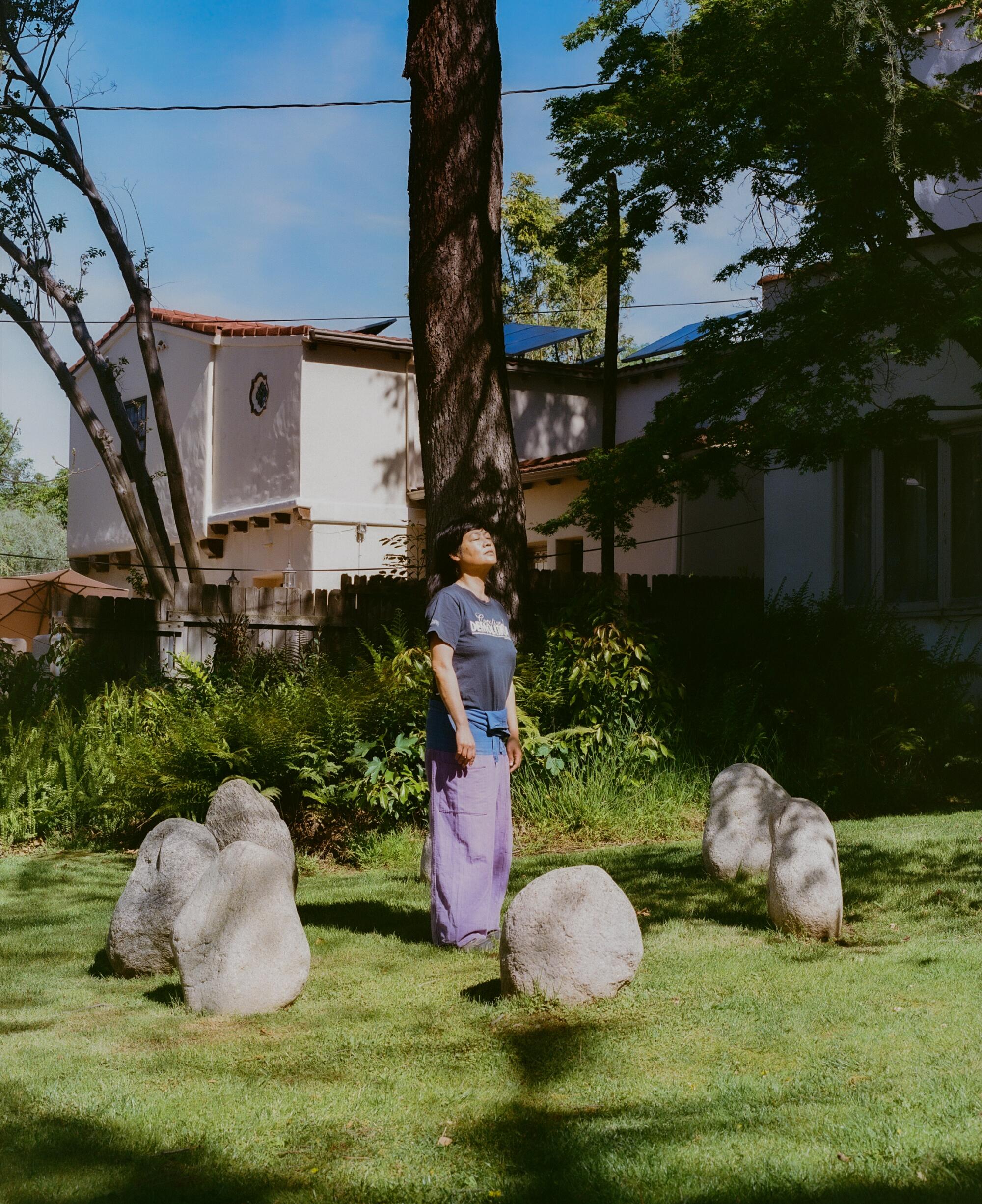
“I think about how catastrophic thinking can be generative, how to not keep it in the loop, but to bring it out into something else,” says Chang.
(June Kim / For The Times)
At the end of the video essay, as the underwater footage fills the screen, Chang reflects on her own death. What if she dies just as her son transitions to adulthood, before he is ready to take care of himself? She calms herself by reasoning, “Perhaps many animals live this way, and it is not a tragedy.” This is one of Chang’s strengths: making pragmatic observations feel poetic. Here, embracing nature’s limits makes the inevitability of death feel strangely expansive, like it connects us to other species and other ecosystem — which of course, it does.
Catherine G. Wagley writes about art and edits at Momus. Her book, “She Wanted Adventure: Five Gallerists Who Gave Their Lives to Art in 1960s and 1970s Los Angeles,” is forthcoming from Farrar, Straus & Giroux (FSG).


